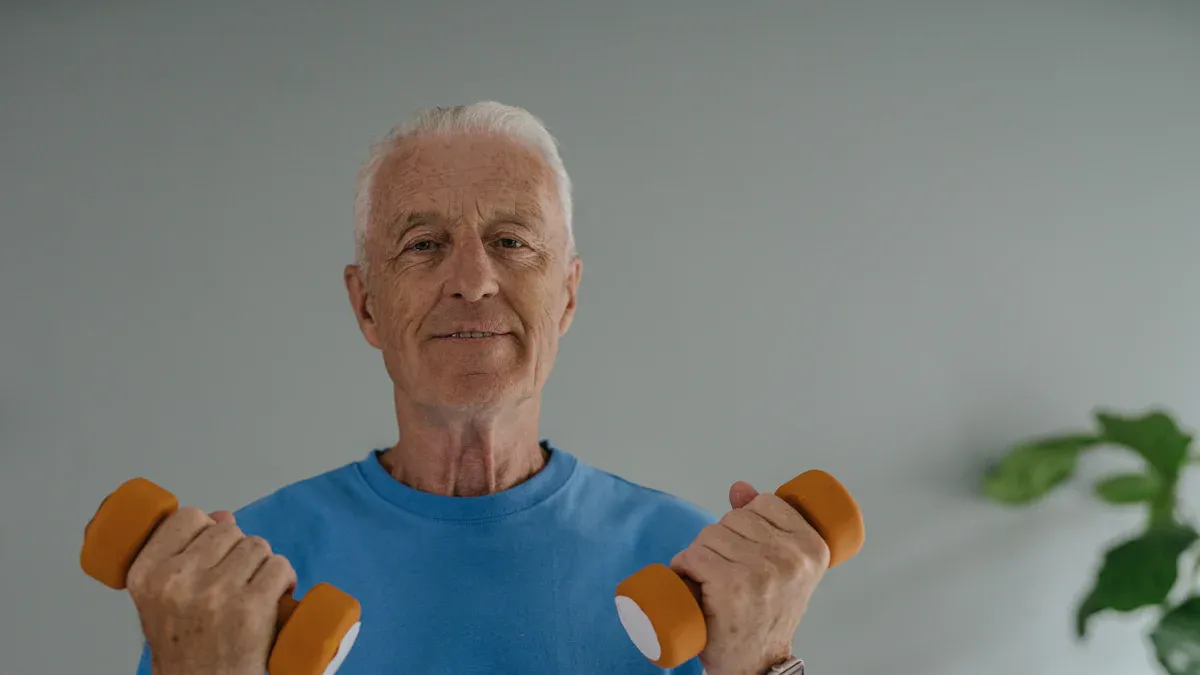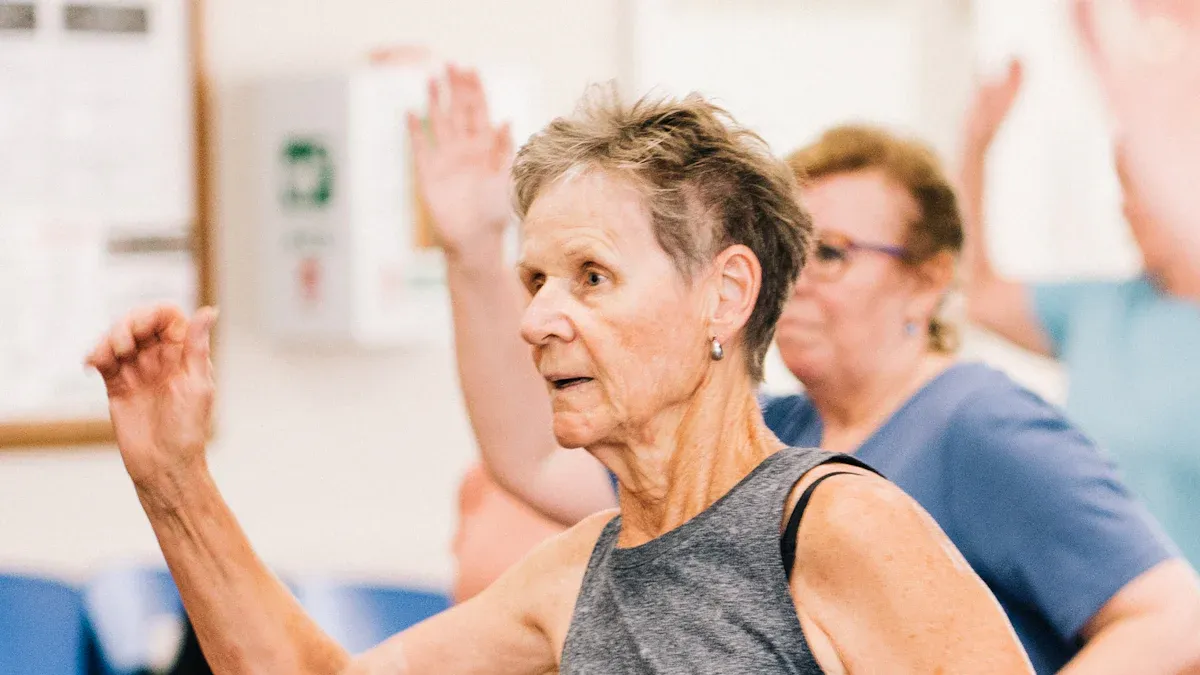Practical Exercise Tips for Caregivers to Stay Healthy

As a caregiver, you probably spend most of your time looking after others. But have you ever stopped to think about your own health? Studies show that 40% to 70% of caregivers experience symptoms of depression, and nearly a quarter report a decline in their physical health. This makes prioritizing your well-being essential—not just for you but for those who depend on you.
Exercise can be a game-changer. It’s not just about staying fit; it’s about feeling better mentally and physically. Moderate activities like walking or yoga can reduce stress, ease fatigue, and even improve your overall health. By making time for movement, you’ll find yourself better equipped to handle the demands of caregiving.
Caregivers often face challenges like chronic health conditions and limited access to mental health services. Taking care of yourself isn’t selfish—it’s necessary.
The role of exercise in caregiver well-being is undeniable. Even small steps can make a big difference in how you feel and function every day.
Key Takeaways
Take care of your health first as a caregiver. Exercise helps you feel happier and more energetic, so you can care for others better.
Add movement to your daily life. Easy things like walking or stretching can lower stress and make you feel healthier.
Be proud of small fitness goals you reach. Keeping track of progress and celebrating success helps you stay motivated and shows why self-care matters.
The Role of Exercise in Caregiver Well-Being
Reducing stress and improving mental health
Caring for someone can feel overwhelming at times, but exercise offers a powerful way to manage stress. Physical activity triggers the release of endorphins, your body’s natural mood boosters. Even a short walk or a few minutes of stretching can help you feel calmer and more focused. A systematic review highlights that structured exercise programs significantly improve caregivers' psychological well-being. Combining physical activity with relaxation techniques, like yoga or deep breathing, can amplify these benefits. Home-based exercises are especially effective since they’re accessible and cost-efficient.
Tip: Start small. Try 10 minutes of light movement daily to ease into a routine.
Boosting energy and stamina for caregiving tasks
You might think exercise will drain your energy, but it actually does the opposite. Regular movement improves blood circulation and strengthens your muscles, giving you the stamina to handle caregiving tasks more efficiently. Whether it’s lifting groceries or assisting a loved one, staying active makes these activities less taxing. Studies show that consistent exercise over nine months can significantly reduce caregiver burden, making daily responsibilities feel more manageable.
Preventing burnout and promoting long-term health
Burnout is a common challenge for caregivers, but exercise can help you avoid it. Physical activity not only reduces stress but also supports your overall health. It lowers the risk of chronic conditions like heart disease and diabetes, which are more common among caregivers. A table summarizing research findings shows how exercise interventions can reduce caregiver burden and promote long-term well-being:
Study Type | Intervention Duration | Effect on Caregiver Burden | Effect Size |
|---|---|---|---|
Various | 9 months | Significant reduction | -0.572 |
Shorter | Less consistent | Variable results | N/A |
Home-based | Cost-effective | Potential for broader use | N/A |
By prioritizing your health, you’re not just helping yourself—you’re ensuring you can continue to care for your loved ones effectively.
Practical Tips for Staying Active as a Caregiver
Multitasking exercise with caregiving duties
You don’t always need a dedicated workout session to stay active. Try combining exercise with caregiving tasks. For example, if you’re helping a loved one with mobility exercises, join in and stretch alongside them. If you’re supervising outdoor play, walk laps around the yard or do light stretches nearby. These small movements add up and keep you moving without taking extra time out of your day.
Tip: Turn caregiving moments into opportunities for movement. It’s a win-win for both you and your loved one.
Using short breaks for quick physical activities
Even a few minutes of activity can make a difference. Use short breaks during your day to fit in quick exercises. Do a set of squats while waiting for the kettle to boil or try a few push-ups against the kitchen counter. These micro-workouts are easy to squeeze in and help you stay energized throughout the day.
Turning daily chores into exercise opportunities
Household chores can double as a workout. Vacuuming, mopping, or gardening can get your heart rate up and work your muscles. Add a little extra effort—like lunging while vacuuming or squatting to pick up items—to turn these tasks into a mini exercise session. You’re already doing the work, so why not make it count?
Scheduling exercise as a non-negotiable appointment
Treat exercise like any other important task on your to-do list. Block out time on your calendar and stick to it. Even 15 minutes of dedicated movement can make a big difference in how you feel. By prioritizing this time, you’re reinforcing the importance of your own well-being. Remember, when you take care of yourself, you’re better equipped to care for others.
Reminder: Your health matters. Make exercise a priority, not an afterthought.
Simple and Accessible Exercises for Caregivers

Walking, gardening, and light cardio
Walking is one of the easiest ways to stay active. You don’t need fancy equipment or a gym membership—just step outside and start moving. A brisk 10-15 minute walk around your neighborhood can boost your mood and energy levels. If you enjoy being outdoors, gardening is another great option. Digging, planting, and weeding not only keep you active but also provide a sense of accomplishment. Light cardio, like dancing to your favorite music, can also get your heart pumping while lifting your spirits.
Tip: Pair your walks or gardening sessions with a podcast or music to make them more enjoyable.
Stretching and yoga for flexibility and relaxation
Stretching helps release tension in your muscles, especially after a long day of caregiving. Simple stretches like touching your toes or rolling your shoulders can improve flexibility and reduce stiffness. Yoga takes this a step further by combining stretches with deep breathing. It’s a fantastic way to relax your mind while keeping your body limber. You can find beginner-friendly yoga videos online that guide you through poses like the child’s pose or downward dog.
Strength training with household items
You don’t need weights to build strength. Everyday items like water bottles, canned goods, or even a sturdy chair can double as workout tools. Use them for simple exercises like bicep curls or tricep dips. Strength training improves muscle tone and makes daily tasks, like lifting or carrying, easier. Start with light items and gradually increase the weight as you get stronger.
Chair yoga and low-impact exercises for joint health
If you have joint pain or limited mobility, chair yoga is a gentle way to stay active. You can perform seated stretches and poses that improve flexibility and circulation without putting pressure on your joints. Low-impact exercises like leg lifts or seated marches are also great for maintaining strength and mobility. These exercises are perfect for days when you need something less strenuous but still want to move.
Reminder: Consistency matters more than intensity. Even small movements can make a big difference over time.
Building a Sustainable Self-Care Routine

Prioritizing rest and recovery
Rest is just as important as exercise. When you’re constantly on the go, your body and mind need time to recharge. Sleep plays a huge role in helping you recover from physical activity and manage stress. Aim for 7-9 hours of quality sleep each night. If that feels impossible, try short power naps during the day. Relaxation techniques like deep breathing or meditation can also help you unwind after a long day of caregiving.
Tip: Create a bedtime routine. Dim the lights, avoid screens, and do something calming, like reading or listening to soft music.
Tracking progress and celebrating small wins
Tracking your progress can keep you motivated. Write down your goals and note each step you take toward achieving them. Did you manage a 10-minute walk today? Celebrate it! Recognizing small wins helps you stay positive and builds momentum. For example, reflecting on your achievements, like Jada did with her action steps, can help you identify what works best for you. This makes it easier to set realistic goals in the future.
Reminder: Progress isn’t about perfection. It’s about showing up for yourself, even in small ways.
Involving loved ones in physical activities
Why not make exercise a family affair? Invite your loved ones to join you for a walk or a fun dance session at home. This not only keeps you active but also strengthens your bond with them. If you’re caring for someone with limited mobility, try seated exercises together. Sharing these moments can make physical activity feel less like a chore and more like quality time.
Idea: Turn it into a game! Challenge each other to see who can do the most steps or stretches.
Creating a home exercise station for convenience
Having a dedicated space for exercise makes it easier to stay consistent. Set up a small corner in your home with basic equipment like a yoga mat, resistance bands, or even household items like water bottles. Studies show that regular physical activity improves mental health and reduces anxiety. Tailored exercise programs can fit seamlessly into your daily routine, especially when designed with your needs in mind.
Benefits of a home exercise station:
Saves time and eliminates the need to travel.
Encourages regular movement, even on busy days.
Helps you maintain a healthy weight and reduce stress.
Tip: Keep your exercise gear visible. Seeing it daily can remind you to stay active.
Taking care of yourself doesn’t have to be overwhelming. Small, consistent steps can lead to big changes in your health and happiness. Celebrating even tiny wins, like a 10-minute walk, activates your brain’s reward system and boosts your motivation. Skipping this can increase stress, so don’t forget to acknowledge your efforts.
When you prioritize your well-being, you’re not just helping yourself—you’re also showing up stronger for your loved ones. Start today with just 10-15 minutes of movement. You’ve got this! 💪
FAQ
How can I stay motivated to exercise as a caregiver?
Tip: Set small, achievable goals and celebrate progress. Pair exercise with something enjoyable, like listening to music or podcasts. Involve loved ones to make it fun.
What if I don’t have time for a full workout?
You don’t need a full workout! Use short breaks for quick activities like stretching or squats. Even 5-10 minutes of movement makes a difference.
Are there exercises I can do with limited mobility?
Absolutely! Try chair yoga, seated stretches, or light resistance exercises with household items. These low-impact options improve flexibility and strength without straining your joints.
See Also
Join Us at Banish Cancer – A Place of Hope
Exploring Symptoms and Therapies for Adrenocortical Adenoma
Key Insights on Adrenocortical Carcinoma Symptoms to Know
An In-Depth Overview of Various Cancer Types Available
Insights into Symptoms and Care for Lymphomatoid Granulomatosis
